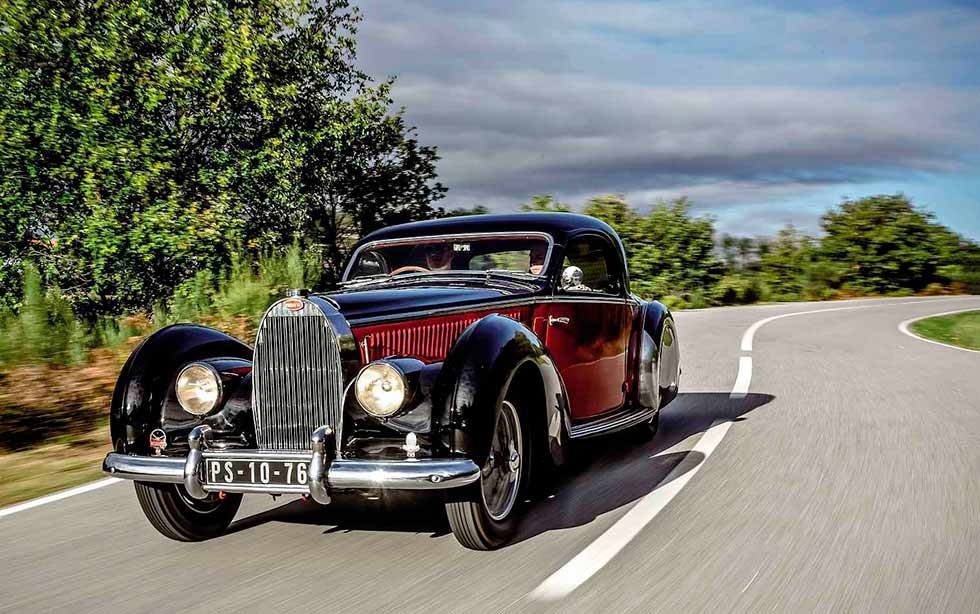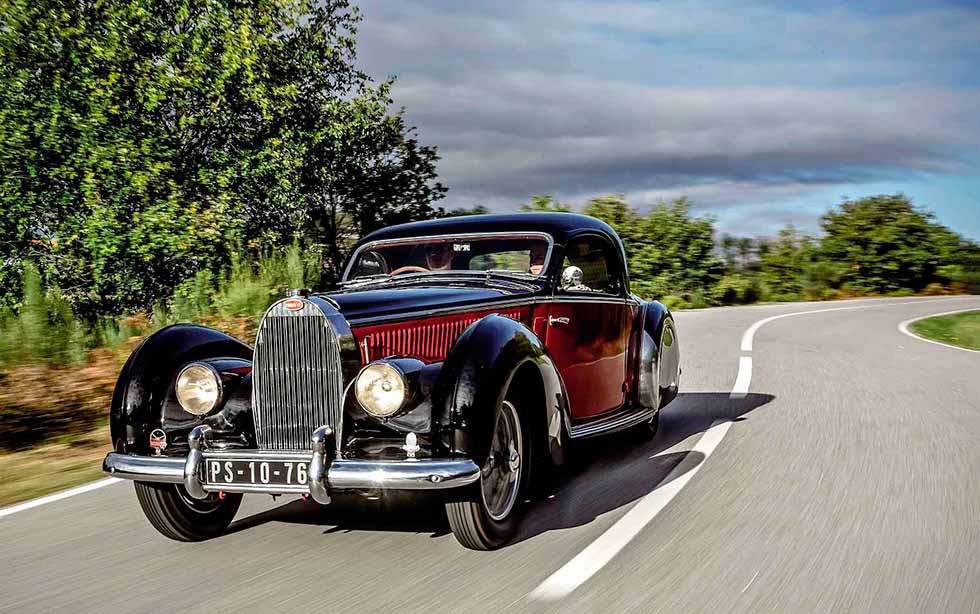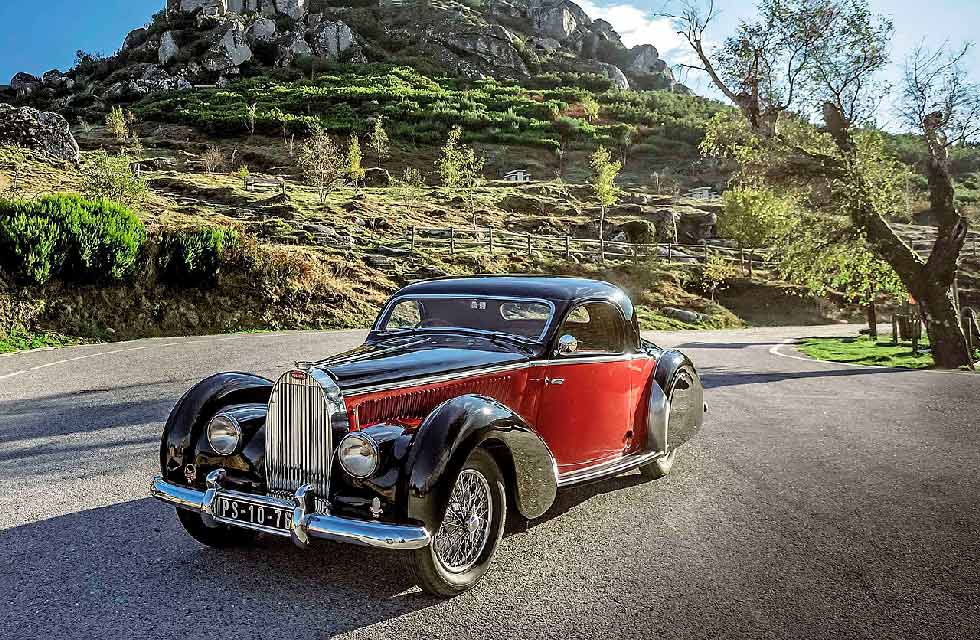
Taste of the exotic Stunning supercharged 1938 Bugatti Type 57C Atalante. Mountain drive in supercharged 57C This spectacular Bugatti Type 57C Atalante has been enjoyed by a variety of long-term owners. Now it’s Octane’s turn… Words Richard Heseltine. Photography Manuel Portugal.
BUGATTI ATALANTE
The hot flush of panic has given way to eye-rolling exasperation. As the sun pulses overhead, all that surrounds us are parched peaks, a smattering of boulders, a couple of outbuildings engulfed by foliage and an ancient lorry in the closing stages of decomposition. Oh, and cows.

Lots and lots of cows, in fact. The seasoned pro who is herding them gesticulates wildly with one hand, while training her stick with the other. She then nods robustly and offers a gummy smile as her livestock finally, reluctantly, move out of the road – the same sliver of asphalt fabulousness that we had been enjoying minutes earlier. It’s like the parting of the Red Sea, except one of her party is clearly not a happy heifer and refuses to budge. Instead, what follows is a staring competition. She wins, unblinkingly, but this is getting old. Full-steam reverse it is, then. No pressure.
There are rarer cars than this 1938 Bugatti Type 57C Atalante, but not many. There are more striking-looking cars, too, but few that arouse such feelings of intense longing at first sight. There may even be better-sounding exotics, but not many spring to mind. The supercharged straight-eight beneath the centre-hinged bonnet sounds beyond strident when pressed. All that is lacking from its armoury is manoeuvrability. That, and rear visibility.
The Atalante has the turning circle of an ocean liner and enough rear-three-quarter blind spots to blot out much of the Serra do Caramulo mountain range. This is made clear during a 27-point turn at the sort of altitude that induces lung burn while changing course to one free of bovine interference. The photographer’s chortles and comic faces aren’t exactly helping, mind.

Somehow you doubt that its long-time owner, João de Lacerda, would have had any such difficulties. From all accounts – and accounts aren’t hard to come by – this Portuguese aristocrat and art connoisseur was a press-on driver who didn’t lift for anything. He acquired the Bugatti in November 1975 and restored it meticulously before it went on display in the family’s Museo do Caramulo collection. Thing is, the Atalante clearly didn’t spend much time as an exhibit as de Lacerda racked up 60,000km in it during road trips to Scandinavia, France, Italy, and large chunks of the British Isles over the next two decades.
He fielded the Bugatti in concours events and countless long-distance rallies with distinction, while also exercising it on-track on occasion. Legend has it that he took great delight in humbling younger fare, but then he did live halfway up an active hillclimb course that doubled as a busy thoroughfare during weekdays, so he had plenty of practice. This was one of his favourite cars, which is saying something given that he also owned countless equally significant Bugattis, not to mention Hispano-Suizas, Ferraris, a Pegaso and other Continental bluebloods.
He was just the sort of owner that Ettore Bugatti would have had in mind when the Type 57 broke cover at the 1934 Paris motor show. This wasn’t his first attempt at a pure road car – witness the voluptuous Type 55 and the Royale that preceded it – but it was every inch the supreme Grand Routier of its generation, a pur sang machine, with all that entails.
The powerplant was, naturally, a work of art; an inline eight-cylinder jewel with twin overhead camshafts driven by gears from the back of the engine. With a bore and stroke of 72mm x 100mm, it had a displacement of 3257cc and produced upwards of 140bhp in normally aspirated form depending on spec, and as much as 200bhp with a Roots blower in-situ. The crankshaft was supported by five main bearings, with a sixth over-slung behind the camshaft drive gears.
Such a powerplant deserved a handsome wrapper, and the factory offered five ‘standard’ outlines, some from the pen of Ettore’s son, Jean Bugatti. These were the four-seat, four-door Galibier, the Stelvio convertible, the two-door, four-seat Ventoux, the two-seat notchback Atalante and the uber-exotic Atlantic coupé, which could have graced the set of Fritz Lang’s Metropolis. The original T57 was followed by the lower, shorter, and sleeker T57S in 1935, while a supercharger became an option from 1938, thus creating the 57C (for Compressor) and SC editions. And despite the 57’s relatively short lifespan (largely curtailed by World War Two), developments and upgrades came in thick and fast, with flexible engine mounts from 1937 and hydraulic brakes and Allinquant telescopic dampers from 1938, for example.
For all the roadgoing intent, 57-derived machinery showed impressive form in competition, with Earl Howe finishing third in the 1935 Tourist Trophy aboard a skimpy, cycle-winged example. A year later, Bugatti dominated the French Grand Prix for sports cars at Montlhéry, as then-future French Resistance heroes Jean-Pierre Wimille and Raymond Sommer shared honours in their 57G with its radical-looking, fully enveloped bodyshell. Wins at Le Mans in 1937 and ’39 mean there’s no denying the pedigree here.
The 57 was also a favourite blank canvas for many of the more fêted metal-bending artists of the day, with the works of Henri Graber, George Gangloff, Joseph Figoni and Corsica Coachworks (named after Corsica Street in North London rather than the island in the Med) to the fore. This car, by contrast, was clothed by the profoundly French Carrosserie Vanvooren, its Courbevoie works having been steeped in coachbuilding that stretched back to the days of horsedrawn carriages. This highly regarded couturier clothed more than 100 Bugattis, including a trio of T50s that participated in the 1930 Le Mans 24 Hours, thanks in part to the close relationship between company director Romée de Prandières and Bugatti’s Paris agent, Dominique Lamberjack.
Vanvooren outlines were rarely outlandish, but they were noticeable. The Caramulo car is a case in point. It was bodied at the behest of a Monsieur Chaussivert, who received the finished article in December 1938. Two years later, it was acquired by Portuguese sportsman Alfredo Marinho, who kept the car until 1948 when ownership passed to Bento de Amorim. He retained the Bugatti until the mid-70s when it was bought by João de Lacerda. Now his grandson Tiago continues the family tradition of exercising it on long jaunts whenever the opportunity arises.
Up close, it is devilishly attractive; the sort of car that befits a cad and a bounder. It’s almost cartoonishly curvaceous and lowslung with it. Distinct from other, ostensibly similar T57s, it has a longer bonnet than normal, which only heightens the sense of theatre, not least because it’s only a few inches taller than the top of the front wings. Add in drop-away side glazing, a tautly curved roofline and that deliciously rounded rump and there isn’t a line wrong on it. Beauty isn’t skin deep, either, the straight-eight’s rectilinear cam covers and engine-turned finish more than matching the outer dazzle.
Stoop to enter the cabin, and you’re rewarded with deliciously patinated leather and the giddying aroma that comes with it. This car smells old but not musty, and uniquely it has a bench seat that can accommodate three occupants at a stretch. The low roofline and high(ish) beltline ensure that you feel vaguely claustrophobic, but that impression soon passes. The vast wood-rim wheel sits atop at least a metre of polished steering column and juts out at chest level. The dashboard is uncluttered, your main point of focus being the Jaeger revcounter, which is calibrated up to 8000rpm. There’s no redline. The speedo, meanwhile, is sited on the passenger side and tops out at 200km/h (125mph), which isn’t as fanciful as you might imagine. This Bugatti produces around 160bhp at 5000rpm and is reputedly capable of an honest 110mph outright. That’s heady stuff for a pre-war road car.
That it fires on the button first time, every time, comes as no great surprise – this is clearly a car that gets used often and as its maker intended. But what strikes you at pottering speeds is how leaden the steering seems. It’s a worm-and-sector set-up and ponderous with it. There’s no feel, at least not unless you count the slight flexing of the wheel itself. The roller-type throttle also takes a little getting used, as does the single-plate clutch. Your initial inkling is that it’s going to be a pig to drive, not least because there is also a right-hand gearchange with no synchro.
With cars of this vintage, it’s usually best to let them do their own thing – within reason, and in their own time, but that isn’t the case here. The faster you go, the better it gets to the point that you’re soon attuned to its foibles and react accordingly. Suddenly, the steering comes alive and feels ideally weighted despite the occasional kickback, which is perhaps as well because the roads around Caramulo are akin to a World Rally Championship tarmac stage in all directions. There are lots of straights and several epic corners with camber changes and steep drop-offs to match.
What’s more, the 57C is fun to drive, not least because it’s riding on large-diameter, narrow-section tyres. According to its current keeper, the Atalante is chuckable; it can be thrown around with abandon. Someway south of ten-tenths, it changes direction with the sort of immediacy that is as unexpected as it is reassuring. The Bugatti certainly doesn’t struggle to keep up with the well-driven camera car, especially uphill where there is torque to spare.
And really, the whole experience is dominated by that glorious straight-eight. There’s oodles of power available from low down in the rev range, and the four-speed ’box is a joy with familiarity. It doesn’t like to be rushed, which is no great surprise, but time your changes accurately while remembering to blip on up- and downshifts and it snicks into place cleanly and smoothly each time. And the noise! It isn’t the ‘tearing calico’ cliché so often used to describe, say, a Bugatti Type 35, and it’s surprisingly quiet at low speeds, but it just bellows under load. The blower adds another layer of sinister sonics, as do the faint gear-whine and the occasional harmonic thrum through the structure. Throw in a little underfloor heat and the occasional whiff of oil and it batters your senses in the best way possible. It’s a completely immersive experience. The Bugatti even rides well. It feels less choppy that you might have expected, although it helps that the roads around Caramulo are free of craters. The brakes perhaps lack bite, but that rather comes with the territory.
This really was about as exotic as road cars got in period. Your lasting impression isn’t so much the straight-eight fanfare, and neither is it its poise on challenging backroads, it’s more the precision with which everything works as a mighty whole. It’s everything you hope and expect a ‘Molsheim’ Bugatti to be and more. Much, much more. It’s been fun. More importantly, it’s been educational.
Thanks To Adelino Dinis and Tiago Patrício Gouveia, www.museu-caramulo.net.
TECHNICAL SPECIFICATIONS 1938 Bugatti Type 57C Atalante
Engine 3257cc straight-eight, DOHC, Stromberg carburettor, Roots supercharger
Max Power 160bhp @ 5000rpm / DIN
Max Torque 185 lb ft @ 3200rpm / DIN
Transmission Four-speed manual, rear-wheel drive
Steering Worm and sector
Suspension
Front: transverse semi-elliptic springs, Houdaille dampers.
Rear: live axle, reversed quarter-elliptic springs, Houdaille dampers.
Brakes Hydraulic drums
Weight 1400kg (est)
Top speed 110mph (est)
0-62mph 9.9sec (est)
‘And the noise! it’s surprisingly quiet At low speeds, but it just bellows under load’
‘Up close, it is devilishly attractive; the sort of car that befits a cad and a bounder’
Above and facing page Glorious Iberian mountain roads are natural territory for the Atalante – bovine truculence notwithstanding. Above and above right Supercharged straight-eight beats behind that imposing grille; patinated cockpit is hugely atmospheric.






